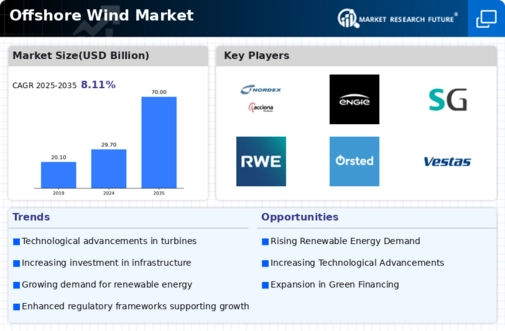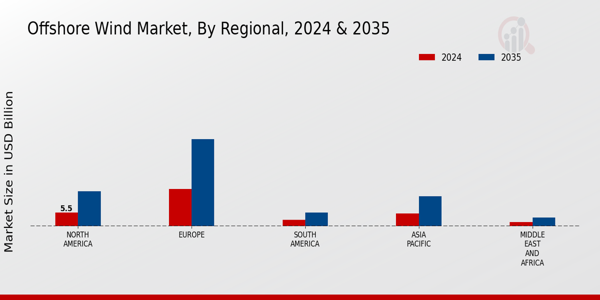Growing Energy Demand
The Global Offshore Wind Market Industry is experiencing a surge in demand for renewable energy sources, driven by the increasing global energy consumption. As countries strive to meet their energy needs sustainably, offshore wind power emerges as a viable solution. In 2024, the market is projected to reach 29.7 USD Billion, reflecting a growing recognition of wind energy's potential. This demand is likely to escalate as governments implement policies aimed at reducing carbon emissions and transitioning to cleaner energy sources. The shift towards offshore wind is not only a response to energy needs but also a commitment to environmental sustainability.
Environmental Benefits
The Global Offshore Wind Market Industry is increasingly recognized for its environmental advantages, which serve as a compelling driver for growth. Offshore wind energy is a clean, renewable source that significantly reduces greenhouse gas emissions compared to fossil fuels. As nations commit to international climate agreements, the demand for sustainable energy solutions rises. The offshore wind sector not only contributes to energy security but also supports biodiversity by minimizing land use. This alignment with global sustainability goals enhances the appeal of offshore wind projects, encouraging investment and development. The industry's potential to mitigate climate change impacts positions it favorably in the energy transition.
Investment Opportunities
The Global Offshore Wind Market Industry presents lucrative investment opportunities, attracting both public and private sector funding. With the market projected to reach 70 USD Billion by 2035, investors are increasingly recognizing the long-term potential of offshore wind projects. The combination of stable returns and growing demand for renewable energy makes this sector an appealing choice for investment. Furthermore, as technology advances and costs decrease, the financial viability of offshore wind projects improves, further enticing investors. This influx of capital is likely to accelerate project development and innovation, ultimately contributing to the industry's growth and sustainability.
Technological Advancements
Technological innovations play a pivotal role in the Global Offshore Wind Market Industry, enhancing the efficiency and viability of offshore wind farms. Advances in turbine design, such as larger rotor diameters and higher capacity factors, are enabling the generation of more energy at lower costs. These developments are expected to contribute to the market's growth, with projections indicating a rise to 70 USD Billion by 2035. Furthermore, improvements in installation techniques and maintenance practices are likely to reduce operational costs, making offshore wind a more attractive investment. As technology continues to evolve, the industry may witness accelerated adoption and expansion.
Government Policies and Incentives
Supportive government policies and incentives are crucial drivers of the Global Offshore Wind Market Industry. Many countries are implementing regulatory frameworks that promote the development of offshore wind projects, including feed-in tariffs, tax credits, and grants. These initiatives not only provide financial support but also create a favorable investment climate for developers. As a result, the market is expected to grow significantly, with a projected CAGR of 8.11% from 2025 to 2035. This regulatory backing is essential for attracting private investment and fostering innovation within the sector, ultimately facilitating the transition to a more sustainable energy landscape.





















Leave a Comment